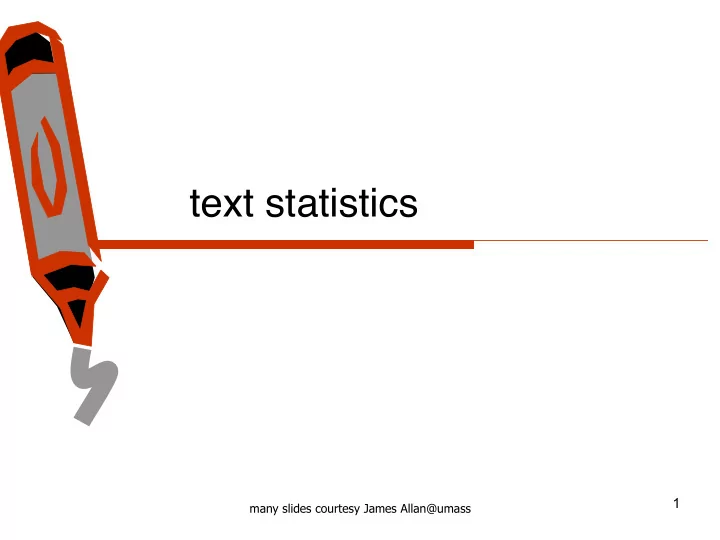

text statistics 1 many slides courtesy James Allan@umass
2
Word � Occurrences � � � Percentage � � the �� 8,543,794 � � � 6.8 � of � � 3,893,790 � � � 3.1 � to � � 3,364,653 � � � 2.7 � and � � 3,320,687 � � � 2.6 � in � � 2,311,785 � � � 1.8 � is � � 1,559,147 � � � 1.2 � for � � 1,313,561 � � � 1.0 � that � � 1,066,503 � � � 0.8 � said � � 1,027,713 � � � 0.8 � � Frequencies from 336,310 documents in the 1GB TREC Volume 3 Corpus � 125,720,891 total word occurrences; 508,209 unique words 3
• A few words occur very often � – 2 most frequent words can account for 10% of occurrences � – top 6 words are 20%, top 50 words are 50% � • Many words are infrequent � • “Principle of Least Effort” � – easier to repeat words rather than coining new ones � � • Rank · Frequency ≈ Constant � – pr = (Number of occurrences of word of rank r)/N � • N total word occurrences � • probability that a word chosen randomly from the text will be the word of rank r � • for D unique words Σ p r = 1 � � � – r ·pr = A � � – A ≈ 0.1 � � George Kingsley Zipf, 1902-1950 � Linguistic professor at Harvard � 4
Top 50 words from 423 short TIME magazine articles 5
6
Zipf’s Law and H.P.Luhn 7
• A word that occurs n times has rank r n = AN/n � � • Several words may occur n times � � • Assume rank given by r n applies to last of the words that occur n times � � • r n words occur n times or more (ranks 1..r n ) � � • r n+1 words occur n+1 times or more � – Note: r n > r n+1 since words that � � occur frequently are at the start of � list (lower rank) 8
• The number of words that occur exactly n times is � I n = r n – r n+1 = AN/n - AN/(n+1) = AN / (n(n+1)) � � • Highest ranking term occurs once and has rank � D = AN/1 � � • Proportion of words with frequency n is � I n /D = 1/ (n(n+1)) � � • Proportion of words occurring once is 1/2 9
Rank 10
Zipf’s law and real data • A law of the form y = kx c is called a power law. � � • Zipf’s law is a power law with c = –1 � – r = A·n -1 n = A·r -1 � – A is a constant for a fixed collection � � • On a log-log plot, power laws give a straight line with slope c . � - log( y ) = log( kx c ) = log( k ) + clog(x) � - log(n) = log(Ar -1 ) = log(A) – 1·log(r) � � • Zipf is quite accurate except for very high and low rank. � 11
high and low ranks 12
• The following more general form gives bit better fit � – Adds a constant to the denominator � – y=k(x+t) c � � • Here, � n = A·(r+t) -1 � 13
• Zipf’s explanation was his “principle of least effort.” � � •Balance between speaker’s desire for a small vocabulary and hearer’s desire for a large one. � � • Debate (1955-61) between Mandelbrot and H. Simon over explanation. � � • Li (1992) shows that just random typing of letters including a space will generate “words” with a Zipfian distribution. � – http://linkage.rockefeller.edu/wli/zipf/ � – Short words more likely to be generated 14
Explanations for Zipf Law • Zipf’s explanation was his “principle of least effort.” Balance between speaker’s desire for a small vocabulary and hearer’s desire for a large one. � � • Debate (1955-61) between Mandelbrot and H. Simon over explanation � � • Li (1992) shows that just random typing of letters including a space will generate “words” with a Zipfian distribution. � � � – http://linkage.rockefeller.edu/wli/zipf/ � � � – Short words more likely to be generated � 15
• How does the size of the overall vocabulary (number � of unique words) grow with the size of the corpus? � – Vocabulary has no upper bound due to proper names, typos, etc. � – New words occur less frequently as vocabulary grows � � • If V is the size of the vocabulary and the N is the � length of the corpus in words: � – V = KN β (0 < β < 1) � � • Typical constants: � – K ≈ 10 − 100 � – β ≈ 0.4 − 0.6 (approx. square-root of n) � � • Can be derived from Zipf’s law by assuming � documents are generated by randomly sampling � words from a Zipfian distribution 16
V =n = KN β 17
Recommend
More recommend